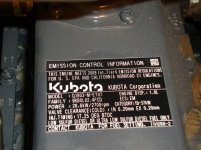Interesting thread... I can honestly say I've never , ever, in over 25 years of diesel repair and fuel injection work seen a diesel set at 0 degrees BTDC for start of fuel delivery. Most are between 15 and 35 degrees BTDC depending on the combustion chamber design and compression ratio.
I have attached a picture of the engine label on my 3400, which works perfectly normal in cold weather in my opinion. Notice the injection timing is 17.25 degrees BTDC.
We've recently done some diesel engine testing through work involving attaching a pressure sensor to the fuel injection line and another one attached to the cylinder head to measure the pressure rise in both areas vs. degrees of crank rotation on a running, loaded engine. There is also a sensor in the injector tip to measure when the needle lifts and injection actually begins. With timing set at 32 degrees BTDC, the actual ignition point is approximately 6 to 9 degrees after TDC on the power stroke. Diesels have a phenomonon called ignition lag, measured in degrees of crank rotation from the time fuel is injected into the combustion chamber until it begins to burn. This is a normal facet of diesel operation, and is why fuel must be injected well before TDC.
That's a V16 turbo intercooled engine turning at 1800 rpm and making well in excess of 1000 HP at full power. We had reliability issues that led to a study of what was happening with combustion pressures and fuel timing.
After experimenting with different injection timing, it was discovered that retarding the timing even 5 degrees resulted in excessively high exhaust gas temperatures, poor combustion, and reduced power for an equivalent amount of fuel consumed. Advancing the timing beyond the original design resulted in extremely high cylinder pressures, cracked and broken connecting rods, etc.
That's 5 degrees or less of change, and here we're discussing retarding it over 15 degrees?? Come on people, have some faith in Kubota and the other manufacturers. They DO know what they're doing, it's one of the reasons they're one of the leaders in small diesels worldwide.
Changing timing affects primarily cylinder pressures, but does have a secondary effect on exhaust gas temperature. Changing the amount of fuel delivered affects primarily the exhaust temperature, with a slight change in cylinder pressure. The two variables are quite different and both are independently adjustable on all diesels I'm aware of.
There's a lot more to adjusting fuel timing than most folks realize. You're changing a design parameter that's been carefully set to provide a balance of the best performance and engine life, while still meeting emission standards.
As some have tried to point out, diesels don't work particularly well when they first start in frigid conditions. Cylinder temps barely support combustion, so yes they will run rough and exhibit grey-white smoke until the cylinders warm up. There's normally a puff of heavy black or grey smoke on start-up, then it will reduce to a lesser level and eventually go away entirely as the engine warms up. The governor will keep adding fuel to maintain idle.
Suggesting that the timing should be set to 0 degrees BTDC regardless of what Kubota has designed it to be, makes absolutely no sense to me. I seriously doubt any dealer will warranty an engine that has had that done, I certainly wouldn't.
And that, my friends, is my opinion.
Sean

